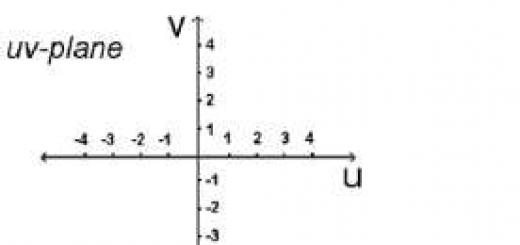All living organisms in nature consist of the same levels of organization; this is a characteristic biological pattern common to all living organisms.
The following levels of organization of living organisms are distinguished: molecular, cellular, tissue, organ, organismal, population-species, biogeocenotic, biosphere.
Rice. 1. Molecular genetic level
1. Molecular genetic level. This is the most elementary level characteristic of life (Fig. 1). No matter how complex or simple the structure of any living organism, they all consist of the same molecular compounds. An example of this are nucleic acids, proteins, carbohydrates and other complex molecular complexes of organic and inorganic substances. They are sometimes called biological macromolecular substances. At the molecular level, various life processes of living organisms occur: metabolism, energy conversion. With the help of the molecular level, the transfer of hereditary information is carried out, individual organelles are formed and other processes occur.

Rice. 2. Cellular level
2. Cellular level. The cell is the structural and functional unit of all living organisms on Earth (Fig. 2). Individual organelles within a cell have a characteristic structure and perform a specific function. The functions of individual organelles in a cell are interconnected and perform common vital processes. In single-celled organisms (unicellular algae and protozoa), all life processes take place in one cell, and one cell exists as a separate organism. Remember unicellular algae, chlamydomonas, chlorella and the simplest animals - amoeba, ciliates, etc. In multicellular organisms, one cell cannot exist as a separate organism, but it is an elementary structural unit of the organism.

Rice. 3. Tissue level
3. Tissue level. A collection of cells and intercellular substances similar in origin, structure and function forms tissue. The tissue level is characteristic only of multicellular organisms. Also, individual tissues are not an independent integral organism (Fig. 3). For example, the bodies of animals and humans consist of four different tissues (epithelial, connective, muscle, nervous). Plant tissues are called: educational, integumentary, supporting, conductive and excretory. Remember the structure and functions of individual tissues.

Rice. 4. Organ level
4. Organ level. In multicellular organisms, the union of several identical tissues, similar in structure, origin and function, forms the organ level (Fig. 4). Each organ contains several tissues, but among them one is the most significant. A separate organ cannot exist as a whole organism. Several organs, similar in structure and function, combine to form an organ system, for example, digestion, respiration, blood circulation, etc.

Rice. 5. Organismal level
5. Organismal level. Plants (Chlamydomonas, Chlorella) and animals (amoeba, ciliates, etc.), whose bodies consist of one cell, are an independent organism (Fig. 5). And an individual individual of multicellular organisms is considered as a separate organism. In each individual organism, all life processes characteristic of all living organisms occur - nutrition, respiration, metabolism, irritability, reproduction, etc. Each independent organism leaves behind offspring. In multicellular organisms, cells, tissues, organs, and organ systems are not a separate organism. Only an integral system of organs that specifically perform various functions forms a separate independent organism. The development of an organism, from fertilization to the end of life, takes a certain period of time. This individual development of each organism is called ontogenesis. An organism can exist in close relationship with its environment.

Rice. 6. Population-species level
6. Population-species level. A collection of individuals of one species or group that exists for a long time in a certain part of the range, relatively separately from other populations of the same species, constitutes a population. At the population level, the simplest evolutionary transformations are carried out, which contributes to the gradual emergence of a new species (Fig. 6).

Rice. 7 Biogeocenotic level
7. Biogeocenotic level. A collection of organisms of different species and varying complexity of organization, adapted to the same conditions of the natural environment, is called a biogeocenosis, or natural community. The biogeocenosis includes numerous species of living organisms and natural environmental conditions. In natural biogeocenoses, energy accumulates and is transferred from one organism to another. Biogeocenosis includes inorganic, organic compounds and living organisms (Fig. 7).

Rice. 8. Biosphere level
8. Biosphere level. The totality of all living organisms on our planet and their common natural habitat constitutes the biosphere level (Fig. 8). At the biosphere level, modern biology solves global problems, for example, determining the intensity of the formation of free oxygen by the Earth's vegetation or changes in the concentration of carbon dioxide in the atmosphere associated with human activity. The main role at the biosphere level is played by “living substances,” that is, the totality of living organisms inhabiting the Earth. Also at the biosphere level, “bio-inert substances” are important, formed as a result of the vital activity of living organisms and “inert” substances (i.e., environmental conditions). At the biosphere level, the circulation of matter and energy occurs on Earth with the participation of all living organisms of the biosphere.
Levels of life organization. Population. Biogeocenosis. Biosphere.
- Currently, there are several levels of organization of living organisms: molecular, cellular, tissue, organ, organismal, population-species, biogeocenotic and biosphere.
- At the population-species level, elementary evolutionary transformations are carried out.
- The cell is the most basic structural and functional unit of all living organisms.
- A collection of cells and intercellular substances similar in origin, structure and function forms tissue.
- The totality of all living organisms on the planet and their common natural habitat constitutes the biosphere level.
- Name the levels of life organization in order.
- What is fabric?
- What are the main parts of a cell?
- What organisms are characterized by the tissue level?
- Describe the organ level.
- What is a population?
- Describe the organismal level.
- Name the features of the biogeocenotic level.
- Give examples of the interconnectedness of the levels of organization of life.
Fill out the table showing the structural features of each level of the organization:
| Serial number |
Levels of organization |
Peculiarities |
Presentation for the lesson "Organismal level of life, its role in nature." Biology 11th grade. First lesson according to the program of I. N. Ponomareva, the purpose of which is to generalize and systematize students’ knowledge about the structural elements, basic processes of the body, as well as the further development of the concept“organismal level of organization of life”, development of skills to highlight the main thing, compare and establish cause-and-effect relationships.
Download:
Preview:
To use presentation previews, create a Google account and log in to it: https://accounts.google.com
Slide captions:
Organismal standard of living, its role in nature, teacher of chemistry and biology, MKOU “Secondary School No. 1”, Povorino, Voronezh region. Efremova Elena Valerievna
Summarize and systematize knowledge about the structural elements and basic processes of the body. Reveal the meaning of the organism's level of life. Tasks:
Updating knowledge What is life? What levels of life organization do you know? What levels of life organization have you already studied? Name the elementary unit and structural elements of the organismal level? How are living organisms classified? What basic processes occur at the organismal level? Name the significance and role of the organismal level in nature.
Life is a higher form of existence of matter compared to the physical and chemical, which naturally arises under certain conditions in the process of its development. Living objects differ from non-living ones in metabolism - an indispensable condition for life, the ability to reproduce, grow, actively regulate their composition and functions, to various forms of movement, irritability, adaptability to the environment, etc.
Biosphere level
Biogeocenotic level
Population-species level
Organismal level
Cellular level Chlorella - single-celled green algae Neurons Onion cells
Molecular level
An elementary unit is an organism, an individual, an individual. Organismal level Structural elements: tissues
Forms of organisms Bacteria Fungi Plants Animals Fungi Plants Animals
Processes: Metabolism and energy. Maintaining a constant composition of the internal environment. Deployment and implementation of hereditary information. Checking the viability of a given genotype. Individual development (ontogenesis).
Significance and role in nature: Maintenance of the biosphere Participation in the cycle of matter and energy Carrier of population properties Individual development, implementation of hereditary information Primary discrete biosystem
Globe http://lambert.wijnvoord.nl/home/globa-asia.jpg Savannah http://img-fotki.yandex.ru/get/5507/mr-serg-bask.77a/0_60627_c2e1a16f_XL Family of wild boars in the forest http ://img-fotki.yandex.ru/get/6601/135834988.5f/0_76b3b_d7ea102e_XL Cod http://www.salmonphotos.com/gallery2/main.php?g2_view=core.DownloadItem&g2_itemId=809&g2_serialNumber=3 Ant http:// antclub.ru/f/8051/camponotus_fallax_01.jpg Tree http://sinisastevovic.files.wordpress.com/2009/11/drvo.jpg Ciliate slipper http://s49.radikal.ru/i123/1004/9b/33bdf70fec7f .jpg Blood cells http://900igr.net/datas/obg/Kurenie/0016-016-Kletki-krovi.jpg Chlorella http://ic.pics.livejournal.com/amelito/1047045/483791/483791_original.jpg neurons http://facstaff.bloomu.edu/jhranitz/Courses/APHNT/Lab_Pictures/nerve_smear.jpg Molecule http://aminoacidsbcaa.com/wp-content/uploads/2012/10/L-Glutamine-zwitterion-3D-balls- 1.png DNA http://cs5029.vkontakte.ru/u29098197/96020247/x_a5ef9a49.jpg
On the topic: methodological developments, presentations and notes
Biology test (grade 9) "Organism level"
This test is built on the principle of a demo version of the GIA in biology and is intended to control students’ knowledge on this topic....
Organismal standard of living. Meaning and role in nature.
The presentation reflects the main points that students should pay attention to during the lesson....
The methodological development of tasks is built in the form of a Unified State Exam, which allows not only to test students’ knowledge on the topic “Organismal standard of living”, but also to develop the skill of correct time management...
In nature, it is expressed primarily in the fact that at this level a basic discrete living unit arose - an organism, characterized by self-maintenance of its structure, self-renewal, actively responding to external influences and capable of interacting with other organisms.
It was at the organismal level that processes expressing the essence of life first appeared in living matter:
- searching for shelters and methods of obtaining food;
- gas exchange as a process of respiration;
- control of physiological processes using the humoral and nervous systems;
- communication between individuals of one's own species and other species.
At the organismal level, the process of fertilization and individual development of an individual first appears as a process of implementation of hereditary information contained in chromosomes and their genes, as well as an assessment by natural selection of the viability of this individual.
Organisms are exponents of the hereditary properties of populations and species. It is organisms that determine the success or failure of a population in the struggle for environmental resources and in the struggle for existence between individuals. Therefore, in all micropopulation processes of historical significance, organisms are direct participants. New properties of the species accumulate in organisms. Selection exerts its effect on organisms, leaving the more adapted and discarding others.
At the organismal level, the bidirectionality of life of each organism is manifested. On the one hand, this is the ability of an organism (individual), oriented towards survival and reproduction. On the other hand, it is ensuring the longest possible existence of its population and species, sometimes to the detriment of the life of the organism itself. This reveals the important evolutionary significance organismal level in nature.
It should also be noted that organisms, participating in food chains to support their vital processes (for the purpose of survival), are actively included as the main carriers of substances and energy in the biological cycle and energy transformation in biogeocenoses. This is expressed global role organisms (autogrophs and heterotrophs) and, in general, the organismal level of life in structure and stability
Getting students in the mood for work.
1. What does biology study?
2. Knowledge of which natural science laws is the basis of the scientific worldview and is necessary for solving practical problems?
3. By what principle is biology divided into separate sciences?
4. Why optimal use of wildlife?
5. What is life?
6. What levels of life organization do you know?
7.What levels of life organization have you already studied?
8.Name the elementary unit and structural elements of the organismal level?
9.How are living organisms classified?
10. What are the main processes occurring at the organismal level?
11.Name the significance and role of the organismal level in nature.
A. The difference between living and nonliving.
Work in groups on assignments:
(Students answer the question and justify their opinion).
Group No. 1:
Can the following organisms be called alive and why:
a) animals in a state of suspended animation;
b) a person under anesthesia;
c) bacteria in a dried state;
d) dry yeast?
Group No. 2:
The constancy of the structural and functional organization of biological systems - homeostasis - as a prerequisite for the existence of biological systems.
Group No. 3:
What phenomenon, characteristic of all living systems, underlies the given facts:
1) the frog cannot live in salt water, but produces a lot of urine in fresh water;
2) live herring in sea water “unsalted”;
3) in human blood containing water, it is necessary to inject saline solution.
Group No. 4:
1. Give examples of living nature systems.
2. Name examples of inanimate systems.
Conclusion: metabolic processes in living matter ensure homeostasis - the constancy of the structural and functional organization of the system.
B). Properties of living organisms:
- Unity of chemical composition.
- Metabolism and energy (metabolism).
- 3. Rhythm.
- 4.Self-regulation
- Self-reproduction.
- Heredity.
- Variability.
- A unified level of organization of living organisms
- Growth and development.
2. Irritability.
3. Discreteness.
4. Adaptability
Select those signs of living organisms that were not discussed in the text of the textbook.
(discretion, self-regulation, rhythm).
Conclusion: living organisms differ sharply from nonliving systems in their exceptional complexity and high structural and functional order. These differences give life qualitatively new properties.
IN). Basic levels of organization of living organisms Living nature is a complexly organized hierarchical system. Scientists, based on the characteristics of the manifestation of the properties of living things, distinguish several levels of organization of living matter.
molecular cellular tissue organ
(molecules) (cell) (tissue) (organ)
organismal population-species
(organism) (species, population)
Biogeocenotic (ecosystem) biosphere.
(BGC, ecosystem) (biosphere)
The diagram shows the individual levels of organization of life, their connection with each other, the flow of one from the other and shows the integrity of living nature.
- group:
- Molecular.
- Cellular.
2. group:
1. Fabric
2. Organ.
- group:
1. Organic.
- Population-species.
As we explain the levels of organization of living organisms in groups, class students fill out the proposed table:
Levels of organization |
Biological system |
Elements forming the system |
|
Molecular |
Organoids |
Atoms and molecules |
|
Cellular |
Cell (organism) |
Organoids |
|
Fabric |
|||
Organ |
|||
Organismal |
Organism |
Organ systems |
|
Population-species |
Population |
||
Biogeocenotic (ecosystem) |
Biogeocenosis (ecosystem) |
Populations |
|
Biosphere |
Biosphere |
Biogeocenoses (ecosystems) |
Conclusion: the structure of living systems is characterized by discreteness, i.e. divided into functional units. Thus, atoms consist of elementary particles, molecules are made of atoms, molecules (large and small) are made of organelles that form cells, tissues are formed from cells, and organs are formed from them, etc.
The identification of individual levels of life organization is to some extent arbitrary, since they are closely interconnected and flow from one another, which speaks of the integrity of living nature.
What forms of organisms are found on Earth?
What is the significance of an organism in nature?
Answer the question using the textbook pp. 5-6 and arrange it in the form of a diagram
The meaning of the organism
- Work at the board:
Match the pictures according to the levels of organization of living organisms
A) Molecular
B) Cellular
B) Fabric
D) Organ
D) Organic
E) Population-species
G) Biogeocenotic (ecosystem)
H) Biosphere






Solving problematic issues:
- "Ozone holes" and the effects of UV rays at the cellular and molecular levels of life.
- It is impossible to treat a person without knowledge of the structure and functioning of cells.
- To solve what global problems of humanity do we need knowledge of biology?
- Give examples of the use of biological science methods from botany, zoology, human anatomy and physiology.
paragraph 1.2 fill out the table.
Creative task for groups: What is the importance of biology for understanding all living things. How did you feel while studying this topic?
 An organism is the basic unit of life, the real bearer of its properties, since life processes occur only in the cells of the body. As a separate individual, the organism is part of the species and population, being a structural unit of the population-species standard of living.
An organism is the basic unit of life, the real bearer of its properties, since life processes occur only in the cells of the body. As a separate individual, the organism is part of the species and population, being a structural unit of the population-species standard of living.
 Biosystems at the organismal level have the following properties: Metabolism Nutrition and digestion Respiration Excretion Irritability Reproduction Behavior Lifestyle Mechanisms of adaptation to the environment Neurohumoral regulation of vital processes
Biosystems at the organismal level have the following properties: Metabolism Nutrition and digestion Respiration Excretion Irritability Reproduction Behavior Lifestyle Mechanisms of adaptation to the environment Neurohumoral regulation of vital processes
 The structural elements of the body are cells, cellular tissues, organs and organ systems with their unique vital functions. The interaction of these structural elements in their totality ensures the structural and functional integrity of the body.
The structural elements of the body are cells, cellular tissues, organs and organ systems with their unique vital functions. The interaction of these structural elements in their totality ensures the structural and functional integrity of the body.
 The main processes in the biosystem of the organismal level: metabolism and energy, characterized by the coordinated activity of various organ systems of the body: maintaining a constant internal environment, deployment and implementation of hereditary information, as well as checking the viability of a given genotype, individual development (ontogenesis).
The main processes in the biosystem of the organismal level: metabolism and energy, characterized by the coordinated activity of various organ systems of the body: maintaining a constant internal environment, deployment and implementation of hereditary information, as well as checking the viability of a given genotype, individual development (ontogenesis).
 The organization of the biosystem at the organismal level is distinguished by a wide variety of organ systems and tissues that form the body; the formation of control systems that ensure the coordinated operation of all components of the biosystem and the survival of the organism in difficult environmental conditions; the presence of various mechanisms of adaptation to the action of factors that maintain the relative constancy of the internal environment, i.e., homeostasis of the body.
The organization of the biosystem at the organismal level is distinguished by a wide variety of organ systems and tissues that form the body; the formation of control systems that ensure the coordinated operation of all components of the biosystem and the survival of the organism in difficult environmental conditions; the presence of various mechanisms of adaptation to the action of factors that maintain the relative constancy of the internal environment, i.e., homeostasis of the body.
 The significance of the organismic level of life in nature is expressed primarily in the fact that at this level a primary discrete biosystem arose, characterized by self-maintenance of its structure, self-renewal, actively regulating the influence of the external environment and capable of interacting with other organisms.
The significance of the organismic level of life in nature is expressed primarily in the fact that at this level a primary discrete biosystem arose, characterized by self-maintenance of its structure, self-renewal, actively regulating the influence of the external environment and capable of interacting with other organisms.

 The vital activity of the body is ensured by the work and interaction of its various organs. An organ is a part of a multicellular organism that performs a specific function (or a group of interconnected functions), has a specific structure and consists of a naturally formed complex of tissues. An organ can perform its functions independently or as part of an organ system (for example, respiratory, digestive, excretory or nervous).
The vital activity of the body is ensured by the work and interaction of its various organs. An organ is a part of a multicellular organism that performs a specific function (or a group of interconnected functions), has a specific structure and consists of a naturally formed complex of tissues. An organ can perform its functions independently or as part of an organ system (for example, respiratory, digestive, excretory or nervous).
 In unicellular organisms, the functional parts of individuals are organelles, i.e. structures similar to organs. An organism is a collection of organ systems connected to each other and the external environment.
In unicellular organisms, the functional parts of individuals are organelles, i.e. structures similar to organs. An organism is a collection of organ systems connected to each other and the external environment.
 All organisms, as individuals, are representatives of different populations (and species) and bearers of their basic hereditary properties and characteristics. Therefore, each organism represents a unique example of a population (and species) in the manifestation of hereditary inclinations, characteristics and relationships with the environment.
All organisms, as individuals, are representatives of different populations (and species) and bearers of their basic hereditary properties and characteristics. Therefore, each organism represents a unique example of a population (and species) in the manifestation of hereditary inclinations, characteristics and relationships with the environment.
 Humoral regulation is carried out through body fluids (blood, lymph, tissue fluid) with the help of biologically active substances secreted by cells, tissues and organs during their functioning. In this case, an important role is played by hormones, which, produced in special endocrine glands, enter directly into the blood. In plants, the processes of growth and morphophysiological development are controlled by biologically active chemical compounds - phytohormones, produced by specialized tissues (meristem at growth points).
Humoral regulation is carried out through body fluids (blood, lymph, tissue fluid) with the help of biologically active substances secreted by cells, tissues and organs during their functioning. In this case, an important role is played by hormones, which, produced in special endocrine glands, enter directly into the blood. In plants, the processes of growth and morphophysiological development are controlled by biologically active chemical compounds - phytohormones, produced by specialized tissues (meristem at growth points).
 In unicellular organisms (protozoa, algae, fungi), many vital processes are also regulated by humoral chemical means through the external and internal environment.
In unicellular organisms (protozoa, algae, fungi), many vital processes are also regulated by humoral chemical means through the external and internal environment.
 During the evolution of living organisms, a new regulation, more efficient in terms of speed of control of functioning processes, emerged - nervous regulation. Nervous regulation is a phylogenetically younger type of regulation compared to humoral regulation. It is based on reflex connections and is addressed to a strictly defined organ or group of cells. The speed of nervous regulation is hundreds of times higher than humoral regulation.
During the evolution of living organisms, a new regulation, more efficient in terms of speed of control of functioning processes, emerged - nervous regulation. Nervous regulation is a phylogenetically younger type of regulation compared to humoral regulation. It is based on reflex connections and is addressed to a strictly defined organ or group of cells. The speed of nervous regulation is hundreds of times higher than humoral regulation.
 Homeostasis is the ability to resist changes and maintain dynamically the relative constancy of the composition and properties of the body.
Homeostasis is the ability to resist changes and maintain dynamically the relative constancy of the composition and properties of the body.
 In vertebrates and humans, impulses sent by the nervous system and secreted hormones mutually complement each other in regulating the vital processes of the body. Humoral regulation is subordinated to nervous regulation; together they constitute a single neurohumoral regulation, ensuring the normal functioning of the body in changing environmental conditions.
In vertebrates and humans, impulses sent by the nervous system and secreted hormones mutually complement each other in regulating the vital processes of the body. Humoral regulation is subordinated to nervous regulation; together they constitute a single neurohumoral regulation, ensuring the normal functioning of the body in changing environmental conditions.
 Nutrition of unicellular organisms Pinocytosis is the absorption of liquid and ions. Phagocytosis is the capture of solid shaped particles. The cell can digest with the help of lysosomes. Lysosomes digest almost everything, even the contents of their cells. The process of cell self-destruction is called autolysis. Autolysis occurs when the contents of lysosomes are released directly into the cytoplasm.
Nutrition of unicellular organisms Pinocytosis is the absorption of liquid and ions. Phagocytosis is the capture of solid shaped particles. The cell can digest with the help of lysosomes. Lysosomes digest almost everything, even the contents of their cells. The process of cell self-destruction is called autolysis. Autolysis occurs when the contents of lysosomes are released directly into the cytoplasm.
 The movement of unicellular organisms is carried out with the help of various organelles and outgrowths of the cytoplasm. The cytoplasm contains a complex network of microtubules, microfilaments and other structures that have supporting and contractile functions that ensure amoeboid movement of the cell. Some protozoa move by wave-like contractions of the entire body. The cell performs active movement with the help of such special formations as flagella and cilia.
The movement of unicellular organisms is carried out with the help of various organelles and outgrowths of the cytoplasm. The cytoplasm contains a complex network of microtubules, microfilaments and other structures that have supporting and contractile functions that ensure amoeboid movement of the cell. Some protozoa move by wave-like contractions of the entire body. The cell performs active movement with the help of such special formations as flagella and cilia.
 The behavior (irritability) of single-celled organisms is manifested in the fact that they can perceive various irritations from the external environment and respond to them. As a rule, the response to irritation consists of spatial movement of individuals. This type of irritability in unicellular organisms is called taxis. Phototaxis is an active response to light. Thermotaxis is an active response to temperature. Geotaxis is an active response to the gravity of the earth.
The behavior (irritability) of single-celled organisms is manifested in the fact that they can perceive various irritations from the external environment and respond to them. As a rule, the response to irritation consists of spatial movement of individuals. This type of irritability in unicellular organisms is called taxis. Phototaxis is an active response to light. Thermotaxis is an active response to temperature. Geotaxis is an active response to the gravity of the earth.
 Multicellular organisms, like unicellular ones, have basic life processes: nutrition, respiration, excretion, movement, irritability, etc. However, unlike unicellular organisms, in which all processes are concentrated in one cell, multicellular organisms have a division of functions between cells, tissues, organs, organ systems.
Multicellular organisms, like unicellular ones, have basic life processes: nutrition, respiration, excretion, movement, irritability, etc. However, unlike unicellular organisms, in which all processes are concentrated in one cell, multicellular organisms have a division of functions between cells, tissues, organs, organ systems.
 Vascular systems transport substances within the body. The respiratory system supplies the body with the necessary amount of oxygen and simultaneously removes many metabolic products. The use of oxygen dissolved in water is the most ancient method of breathing. Gills are used for this. In terrestrial vertebrates, the respiratory system consists of the larynx, trachea, paired bronchi and lungs.
Vascular systems transport substances within the body. The respiratory system supplies the body with the necessary amount of oxygen and simultaneously removes many metabolic products. The use of oxygen dissolved in water is the most ancient method of breathing. Gills are used for this. In terrestrial vertebrates, the respiratory system consists of the larynx, trachea, paired bronchi and lungs.
 The processes of respiration and the release of metabolic products in many highly organized animals, especially those of large size, are impossible without the participation of the circulatory system. CS first appeared in worms. In arthropods, mollusks and chordates, the CS has a special pulsating organ - the heart. In addition to the main role (ensuring metabolic processes and maintaining homeostasis), the CS of vertebrates also performs other functions: maintains a constant body temperature, transfers hormones, participates in the fight against diseases, in wound healing, etc.
The processes of respiration and the release of metabolic products in many highly organized animals, especially those of large size, are impossible without the participation of the circulatory system. CS first appeared in worms. In arthropods, mollusks and chordates, the CS has a special pulsating organ - the heart. In addition to the main role (ensuring metabolic processes and maintaining homeostasis), the CS of vertebrates also performs other functions: maintains a constant body temperature, transfers hormones, participates in the fight against diseases, in wound healing, etc.
 Blood is a liquid tissue that circulates in the circulatory system. All vertebrates have cellular, or formed, elements in their blood. These are red blood cells, white blood cells and platelets.
Blood is a liquid tissue that circulates in the circulatory system. All vertebrates have cellular, or formed, elements in their blood. These are red blood cells, white blood cells and platelets.
 Tasks and questions 1. Describe the differences between the organismal standard of living and the population-species standard. 2. Using the example of any mammal, name the main structural elements of the “organism” biosystem. 3. Explain what signs allow us to classify the tuberculosis bacillus in a patient, a perch in a river, and a pine tree in a forest as organisms. 4. Describe the role of control mechanisms in the existence of a biosystem. 5. How is self-regulation of vital processes carried out in the body? 6. Explain how single-celled organisms absorb and digest food. Describe how single-celled organisms navigate their environment.
Tasks and questions 1. Describe the differences between the organismal standard of living and the population-species standard. 2. Using the example of any mammal, name the main structural elements of the “organism” biosystem. 3. Explain what signs allow us to classify the tuberculosis bacillus in a patient, a perch in a river, and a pine tree in a forest as organisms. 4. Describe the role of control mechanisms in the existence of a biosystem. 5. How is self-regulation of vital processes carried out in the body? 6. Explain how single-celled organisms absorb and digest food. Describe how single-celled organisms navigate their environment.










